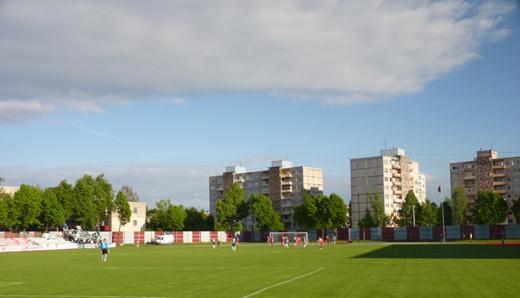The Lithuania Report.
After less than an hour crammed into the back of a Fokker propjet, I made the transition from Latvia to Lithuania. My plan, based on advanced checks on the fixtures was to see the only A Lyga game on the Tuesday, when Dainava played Tauras in a mid-table match, and then to follow this with the top two Zalgiris v Ekranes. I still had not decided on arriving in Riga whether to hire a car or to use buses and stay overnight in Alytus after the Dainava game.
In the end, my decision was made for me. While I was in Riga, I discovered that the fixture detail had been changed during the week before the matches, and my favourite Wednesday game, Zalgiris Ekranes game was not to be played in the capital, but in Marijampole, a two hour bus ride away. This meant there was no public transport from there (or any other game) suitable to return me to the capital in time for my 6.30 flight on Thursday.
And so on arrival at the airport, my first job was to check car hire prices. A local company offered me three days for around £100, and knowing that Hertz, operating out of the next office bar one were charging almost twice as much, I took it straight off. Now comes the bit where modern technology really helps. Instead of trying to read a map and drive in an unknown country, my SatNav found the route to the hotel straight away. Still, it took some time after spotting the road, in a rather run down suburb, to find the hotel which turned out to be ultra-modern once one entered. Clean, bright, spacious and while the breakfast did not add to much, the internet worked.
It took only ten minutes to walk to the town centre. Vilnius is larger than its rivals in Tallinn and Riga, and very well preserved. There are more churches than you could worship at in a month of Sundays. The country is predominantly Catholic and signs in the city centre commemorated a visit by Pope John Paul II in 1993. I managed a good walk around before the sun went down, and then entered a local establishment that provided a very palatable wheat beer, as well some food.

Vilnius Cathedral one of many churches in the Capital, although not typical of the local style!
There is a strong but friendly rivalry between the three Baltic nations, all of which left the Soviet Union in 1991 and joined the European Union (and NATO) in 2004. I believe all three would like to embrace the Euro, but progress has been slowed by the recent economic crisis, which has put a halt to recent growth. There is one significant difference, Estonia and Latvia have never been other than small countries trying to fend off (not always successfully) the superpowers of the region, Sweden, Russia, Poland and Lithuania.
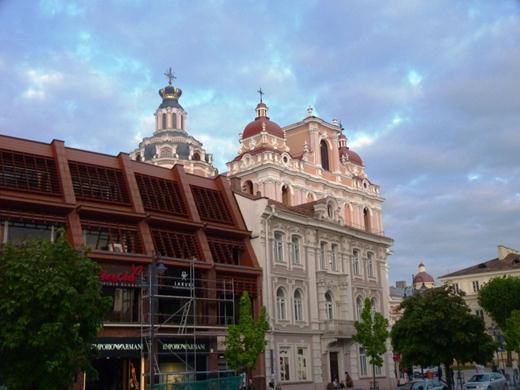
Lithuania (as part of a shared commonwealth with Poland) was the power in central Europe from the 15th to 18th centuries. The Grand Duchy of Lithuania included the current states of Belarus, Ukraine and Moldova, as well as parts of other states such as Romania, Poland and Russia. Even now it is larger than either Latvia or Estonia in terms of area and population the three together have about one and a half times the population of Scotland, in an area which is almost twice the size of Scotland. I know the standard comparison unit is normally Wales, but I feel Scotland needs some recognition.
The local rivalries extend to the football field, and the trio have created a number of cross border challenges, which are almost completely ignored by the local populations. The three day, three match triangular tournaments are a favourite, even though these can never give the best of football. These are biased in favour of the home team, and the last two were won by the home team. Lithuania won a international series held in Kaunas last June, while Skonto won the champions completion, held at their indoor arena (which includes a full sized pitch) in January. The tournament total attendances were not exactly spectacular. The three games in Kaunas totalled a crowd of around 2000, whereas only 500 people headed to the Riga tourney.
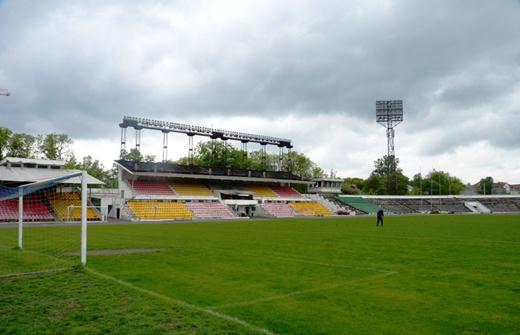
The Zalgiris Stadium in Vilnius, although not currently in use, the pitch looks worn, and there is a groundsman working on it.
In ranking terms, Lithuania lead the way they are ranked 54 by FIFA, ahead of Latvia (75) and Estonia (82), while UEFA rankings for clubs places Lithuania in 32nd , Latvia one lower, and Estonia 43rd. This gives all of them four entries in European competition, and all starting at the same stages. (Wales are 46th, Northern Ireland 49th). This is also reflected in attendances the Estonian League has (according to European Football Statistics) an average “crowd” of just 188 in 2010, Latvia had 448, while Lithuania gets 880.
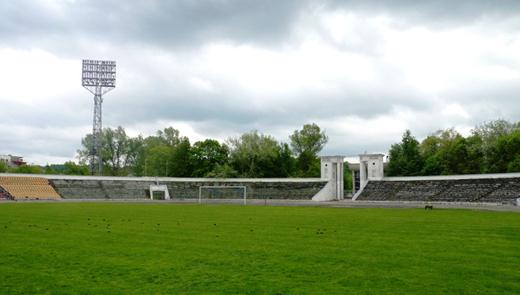
Zalgiris again.
So Tuesday morning arrived, rather dull and damp, and making me pleased to have explored the city centre in the previous evening’s sunshine. Fortunately, conditions improved allowing me to make the drive to Alytus in reasonable weather. The countryside was a mixture of woodland and agricultural land, but little of any great interest. At no point did I feel compelled to stop and admire the scenery.
As for Alytus, it would be easy to dismiss it as an ugly town, but this is a little unfair. It is bland and apparently uninteresting, but has a saving grace in the form of a large expanse of parkland that comes right into the centre of town, keeping the regulation apartment buildings at bay. Within this area is the Alytaus miesto Stadionas. (The extra “a” in the place name is correct, and I assume is possessive), miesto Stadionas means Town Stadium. What one gets is a very neat, and very new (it replaces another stadium on the same site). The press offices told me that it now holds 3700 seats, with two stands each the length of the pitch a larger covered one on one side, and a lower open area opposite. The ground boasts the almost obligatory athletics track, with no facilities at either end. Neither stand has any elevation, so at least 10% of the seats are best avoided as too low.
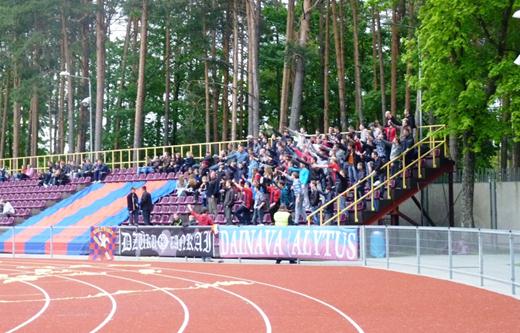
The home fans at Dainava. A smaller number of away fans take up position at the other end of the stand
This probably ranks the stadium only behind the new stadium in Marijampole as the second best in the country, and during the week before my visit, it had the honour of staging the National Cup final.
The team name Dainava refers to an area within the city of Alytus. The visitors were Tauras, from the city of Taurage. This appears just to be a contraction of the town name, taking the local spelling for a zodiac sign and naturally using a bull on their badge. It appears that the city names are rarely included in the club’s official names here, although Klaipeda, Mazeikiai, Siauliai and Kaunas are all just place names. Suduva is the area which includes Marijampole. Zalgiris is the local name for the major battle that cemented Lithuanian power early in the 15th century (English history books would refer to it as the Battle of Grunwald).
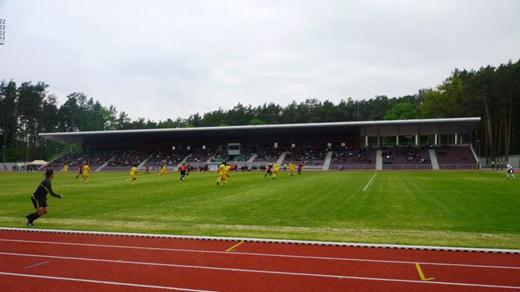
The main stand at Dainava, Alytus
Unlike in Latvia, people were allowed to smoke in the stands, and there was a beer tent at one end providing lager and dark beer, as well as soft drinks. No food, tea or coffee though. The crowd was the best of the tour, and if the official figure around 2000 is correct, then it just about eclipses the total of the other five games seen in Latvia and Lithuania. Admission was 5 lita for any part of the ground, with the majority taking cover, but the “ultras” from each side settling for the end sections of the open area.
As for the game, it was of pleasantly good quality, certainly better than anything I had seen during the Latvian part of the tour. The visitors had an assembled a squad including a number of foreigners, and the name that stood out was Seedorf. Sadly this was Regilo Seedorf, and I suppose the fact he plays in the Lithuanian League, having tried his luck in the Netherlands, Belgium and the Cypriot second division gives away that he is not quite as good as his Uncle Clarence.
While Seedorf was trying to run the midfield, it looked as if the game could go to Dainava, but as soon as Tauras decided to miss the centre of midfield and play the wings, the game changed in their favour. The opening goal came seven minutes before the break, when Borisovs played down the left wing and crossed the ball for the right winger, Buitkus to finish.
The home side levelled the scores direct from a free kick early in the second half, but never looked likely to capitalise on this. Instead most of the second half seemed to be a series of fouls on the visitors wingers. The inevitable happened with 15 minutes to play, as one of the series of yellow cards collected by Dainava was a second, and substitute Strauka left the field early. With three minutes to play, a splendid passage of play involving all three of the Tauras substitutes resulted in a winning goal. One player ran with the ball, passed it out to the left wing, and then the cross was met by a good header which looped over the home keeper.
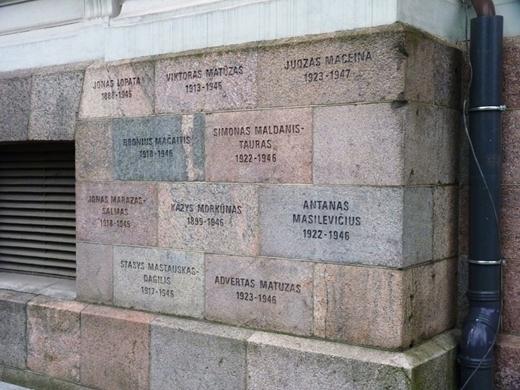
The names engraved on the outside of the “KGB Museum” commemorate some of those deported or killed after incorporation in the Soviet Union
Heading back overnight to Vilnius allowed me to start again the following day, even though I would be repeating my steps to a large extent. It did allow me to enter the museum of the genocide victims, otherwise known as the KGB museum. On the two upper floors, this consisted of a highly politicised view of the resistance against first German and then Russian occupation of the country from 1940 to 1991, and the lives they lived if caught and deported . It is the basement, however that holds the power to shock. This is a dank prison, almost unchanged since the Soviets left in 1991, and was there place were the regime first took those who offended it for interrogation and imprisonment, before shipping them to Siberia, or simply executing them within the building. (No photos permitted), but the outside of the building is now engraved with some of the names of those killed.
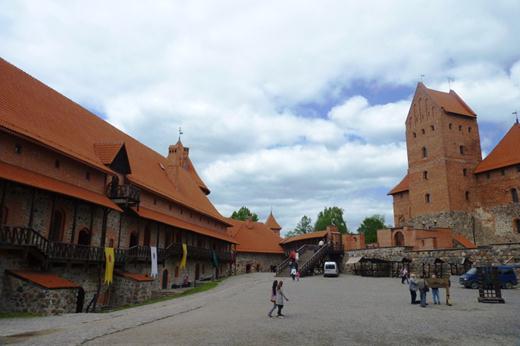
While my trip to Marijampole covered many of the same roads as the previous day, I started earlier, and this allowed a stop in Trakai. Here an interesting and picturesque castle sits in the centre of a lake. The building has been restored and the new red brick stands out starkly against the older parts of the building. The oldest parts of the castle date back to the 14th and 15th century, but it fell into disrepair after the battle of Zalgiris. Just not needed when peace ruled! The modern restoration was carried out mainly in the 1950s.
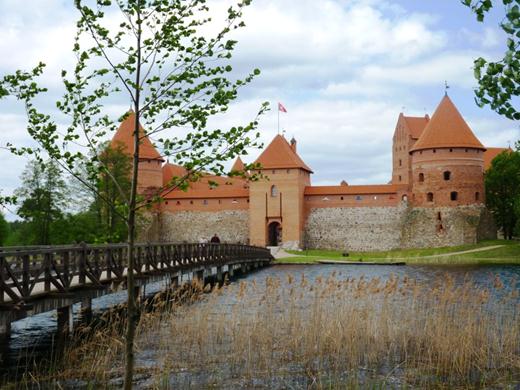
Trakai Castle restoration in redbrick!
Marijampole may be the current host of Lithuania’s national team matches, but it is not an exciting city. The town centre consists of a sterile concrete square and a couple of supermarkets. The two football grounds are situated to the north of the centre, only around 400 metres apart. Suduva used to play at the Suduvos Stadionas, before moving to the new stadium when constructed in 2008. The new stadium seats 6250 and originally had the same name as its predecessor, before naming rights made it into the “Avri” Arena. The older ground was similar to that visited the day before, older and slightly larger, but still a main stand along one side, and a low bank of uncovered seats opposite, and nothing but the track at either end. No admission was charged, and the “home” fans were provided with a free coach from the capital, but still I estimated the attendance at just 150, (officially it was 500). I chose the game as it was the “big” game both sides could end the day top of the league, and also because there may be few chances to return and visit this stadium.
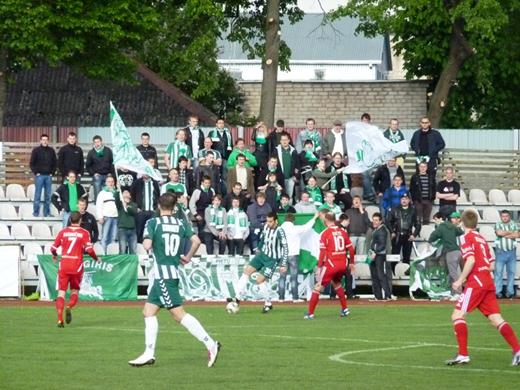
Zalgiris’ travelling support (for a home game) try to get behind their team.
In the short term, this does not seem to mean much. Not only have Zalgiris to play more games here, but also FBK Kaunas had switched their game for the following Sunday. While it was easy to discover that Zalgiris had a problem with their home stadium being considered unsuitable for a A Lyga license, and the planned new stadium being still on same drawing boards as it was on 10 years or more ago, the reasons for other matches moving was unclear.
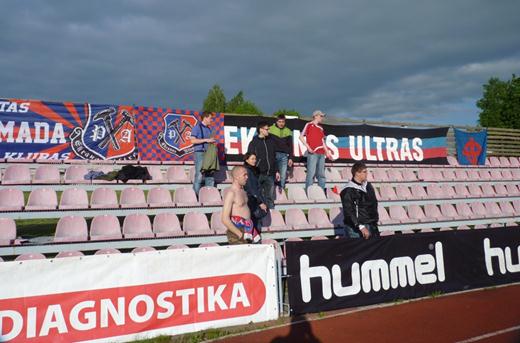
Meanwhile, the travelling Ekranes Ultras try to look menacing.
Meanwhile, Suduva were actually supposed to be away to Atlantas in Klaipeda, but had switched to playing at home, and kicking off 90 minutes before the Zalgiris game. This was an annoyance to me, who would have doubled up had the matches been two hours apart. Indeed there may have been some local sympathy for my position. Some 30 or 40 people entered the ground around half an hour after kick off, many wearing Suduva colurs.
I could not find out why Kaunas, who have played their other games in their home city were to switch a game here. It cannot be for the crowds though Dainava appear unique in getting 2000 in for their mid table games. The others are all under the 1000 mark.
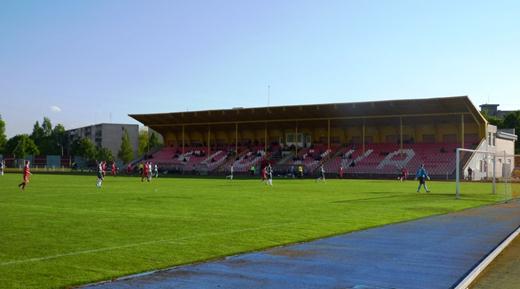
As for my game, it was settled by an early goal scored by Ribokas for league leaders Ekranes. After this, Zalgiris seemed to be able to command most of the play, and unleashed plenty of shots, but hardly any that were anywhere near the target. With the early goal secured, the visitors were content to defend deep against opponents that seemed to lack any sort of punch. Their own attacks were rare, but were more concise and precise.
Ekranes were always good to hold on to their lead, and the game finished 1-0. Most of the play was uninspiring, and it was a surprise when Austraukas of Zalgiris managed to get himself a red card a few minutes before time. I did not think anyone was going to be committed enough to make a serious foul.
I travelled back using the motorway route, through Kaunas soon after dusk, but early enough to see it has a small historic centre and may be worth a visit on another trip. I managed to sleep a little in a quiet service area, and hence delayed arriving in the capital until around 3 am, heading straight to the airport for my 6.30 flight.
